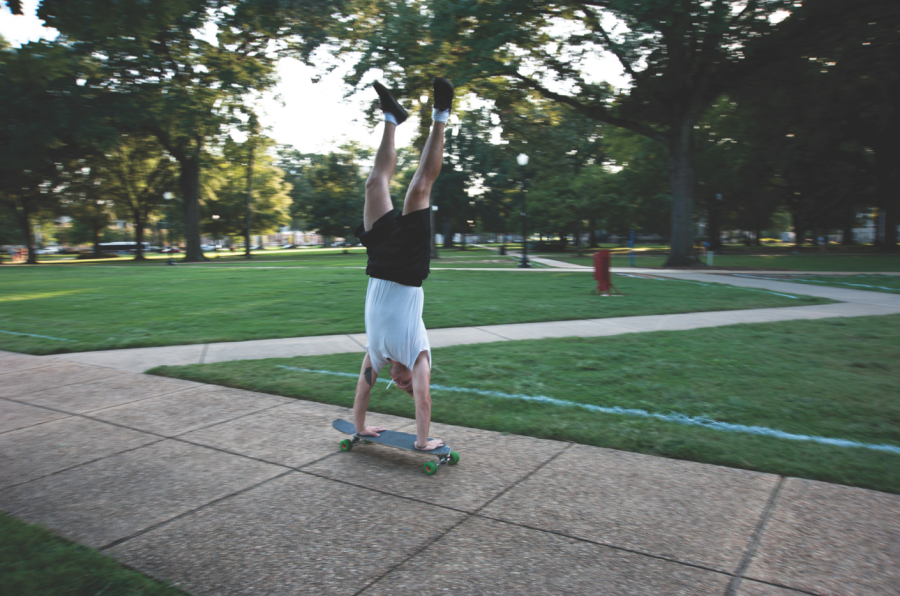As a teenager, Scott Strength used to longboard as a hobby, thinking it was just a fad that would fade. Now, the junior majoring in construction engineering is secretary of the UA Longboard Club and is planning a two-day skating event in September.
“I had done a little bit of shortboarding in high school, but I kind of quit when I came to college,” Strength said. “There wasn’t anywhere to ride. There were no [skate] parks or anything here.”
One night, Strength said he was riding his friend’s board in an empty parking lot and fell in love with riding all over again.
Longboarding differs from skateboarding in that it features a slightly longer board and is more concerned with fast riding, commuting and stunts. Longboards have larger, softer wheels, and the extra length helps riders maintain stability when racing down hills.
Unlike Strength, Coady Latimer, a sophomore majoring in geology, said he’s been longboarding for more than 11 years.
“I’m from Gainesville, Fla., so I grew up around the beach and surfing,” Latimer said. “I’ve been surfing for around 13 years now, and I’ve always been a guy who loves all sports – so it was only natural for me to jump on a longboard. I started a surf and skate club in high school, so when I came to Bama, I wanted to see if there was something similar, so I found the original group on Facebook.”
Latimer served as president of the UA Longboard Club before they became an official, source-certified group in February. Strength said he was the one who pushed the group to become official.
“The network was already there, and the longboarders were at UA, but it was mostly run off of Facebook,” he said. “I’ve actually founded a student organization before, and so I worked with them on that.”
Strength then found Colleen Geary, a UA kinesiology professor, to serve as the group’s faculty advisor.
“She said she would absolutely love to support the organization, and longterm, she’s actually expressed interest in us trying to maybe turn this into a club sport,” Strength said.
David Zagardo, a junior majoring in physics, became a member one Sunday afternoon while skating around campus.
“I saluted my fellow longboarder when I saw him, and we both slowed down and began to talk,” Zagardo said. “Ultimately, he got my number and invited me to the club.”
Zagardo, who’s been involved in various sports for more than 15 years, said the rush of longboarding is his favorite part.
“What gets me most about longboarding is the rush of epinephrine that surges through your body as you ride tucked down a hill going 35-40 mph,” he said. “For me, it’s another way to feel alive without having to fight a bear or run from a lion.”
UA’s longboarding event, called “Get Licked,” is a way for the club to grow their membership and give back to the community in the future. It’s also a way for longboard lovers to show off their skating talents.
“Originally when we had this in mind, it was something that was going to be a lot smaller and take place on campus,” Strength said.
Strength said he hoped the club could raise enough money to donate to the Brayden House, which houses parents with children in DCH’s neonatal intensive care unit, but because of how much the event grew, what little money left is being used for prizes.
“We hope to grow the event and make it a bigger thing,” Strength said. “We’re still going to be hopefully working with the Brayden House on this event and possibly future events when we can get it big enough.”
The event will feature a judged slide jam competition, a longest slide competition, a classic luge race and a downhill speed board race – the main event.
The UA Longboard Club isn’t the only one of its kind in the Southeast. The University of Florida has its own group, as do schools in California and Colorado, where skating and surfing are extremely popular.
And with the growth of longboarding comes new riders.
“I can’t count the number of times I’ve seen kids who have never touched a board before try to ride to class and end up falling and hitting people because they don’t know what they’re doing,” Latimer said. “A word of advice is to learn and practice in a parking lot somewhere before you get out on the roads.”
Zagardo suggested new riders start slow, taking it one step at a time.
“Don’t let your ego get in the way and try to bomb a hill that’s clearly too big for you a few days after you step foot on a board,” he said. “Learn to stop and reduce speed using different methods – foot braking, sliding, et cetera. The best rule of thumb I can give to a beginner is never skate faster than a speed at which you can stop from safely and without injury.”
Latimer, though, had the best piece of advice for inexperienced skaters.
“Always wear a helmet when practicing and learning,” he said. “Brain damage and facial reconstructions are not fun things.”









